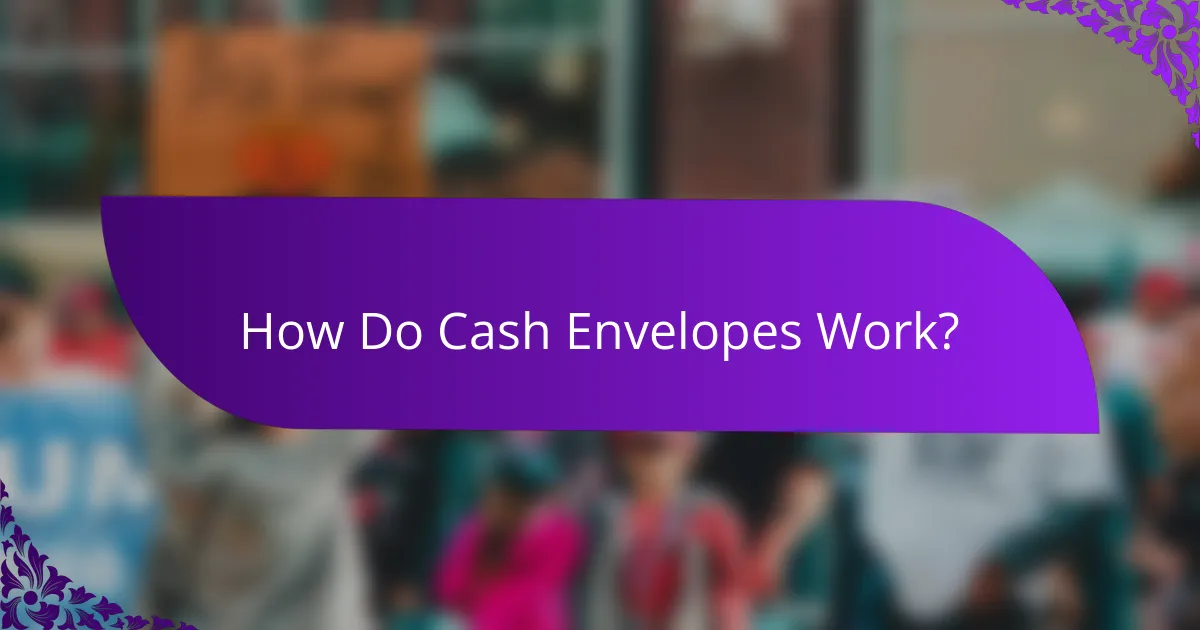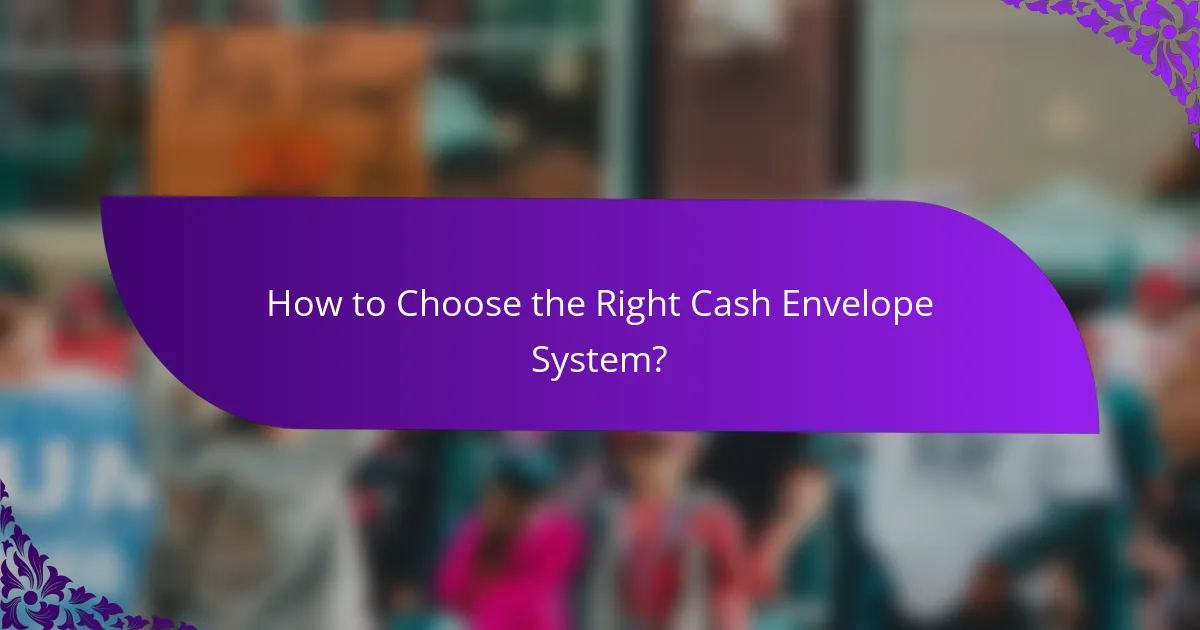The cash envelope system is a practical budgeting method that involves allocating physical cash into specific envelopes designated for various spending categories. This technique not only helps individuals manage their finances more effectively but also encourages discipline by limiting spending to the cash available in each envelope, ultimately fostering greater financial awareness and control.

How Do Cash Envelopes Work?
The cash envelope system is a budgeting method where you allocate physical cash into designated envelopes for specific spending categories. This approach helps individuals manage their finances by limiting spending to the cash available in each envelope.
Physical cash allocation
In the cash envelope system, you withdraw a set amount of cash each month and divide it into envelopes labeled for different expenses, such as groceries, entertainment, or transportation. This physical separation of funds makes it easier to visualize and control spending.
For example, if your monthly grocery budget is $300, you would place $300 in the grocery envelope. Once the cash is gone, you cannot spend any more on groceries until the next budgeting period, encouraging discipline in spending.
Budgeting categories
Choosing the right budgeting categories is crucial for the effectiveness of the cash envelope system. Common categories include necessities like housing and utilities, as well as discretionary spending such as dining out and hobbies.
It’s advisable to limit the number of categories to avoid complexity. Aim for around five to ten envelopes, focusing on areas where you tend to overspend. This targeted approach helps in maintaining control over your finances.
Tracking expenses
Tracking expenses within the cash envelope system involves monitoring how much you spend from each envelope throughout the month. You can do this by keeping a simple log or using budgeting apps that allow you to input cash transactions.
Regularly reviewing your spending helps identify patterns and areas for improvement. If you consistently run out of cash in a particular envelope, consider adjusting your budget or spending habits to better align with your financial goals.

What Are the Benefits of Using Cash Envelopes?
The cash envelope system offers several advantages for managing personal finances, including better budgeting, reduced overspending, and increased financial awareness. By allocating specific amounts of cash for different spending categories, individuals can gain control over their finances and make more informed decisions.
Improved budgeting discipline
Using cash envelopes fosters improved budgeting discipline by requiring individuals to allocate funds for specific categories, such as groceries or entertainment. This method encourages users to stick to their predetermined limits, making it easier to resist impulsive purchases.
To implement this, create envelopes for each spending category and fill them with the cash you plan to spend each month. Once the cash is gone, no more spending should occur in that category until the next budgeting period.
Reduced overspending
The cash envelope system significantly reduces overspending by limiting access to funds. When individuals can only spend what is in their envelopes, they are less likely to exceed their budgets, leading to more responsible financial habits.
For example, if you allocate $300 for groceries in a month, once that cash is depleted, you must wait until the next month to purchase more groceries. This restriction helps prioritize essential purchases over non-essentials.
Enhanced financial awareness
Cash envelopes enhance financial awareness by providing a tangible way to track spending. Handling physical cash allows individuals to see exactly how much they have left in each category, promoting a better understanding of their financial situation.
To maximize this benefit, regularly review your envelopes and adjust your budget as necessary. This practice can help identify spending patterns and areas where adjustments may be needed to achieve financial goals.

How Effective Are Cash Envelopes for Budgeting?
Cash envelopes can be highly effective for budgeting as they promote discipline in spending by allocating specific amounts of cash for different categories. This method helps individuals visualize their spending limits and avoid overspending in any given area.
Success rates among users
Many users report significant success with the cash envelope system, often citing improved control over their finances. Anecdotal evidence suggests that individuals who consistently use this method can reduce discretionary spending by up to 30% compared to those who rely solely on digital payments.
Success rates can vary based on personal commitment and financial habits. Users who set clear goals and regularly assess their spending tend to achieve better outcomes with cash envelopes.
Comparison with digital budgeting tools
While digital budgeting tools offer convenience and automation, cash envelopes provide a tangible approach that can enhance awareness of spending. Digital tools may track expenses automatically, but they can sometimes lead to overspending due to the ease of electronic transactions.
For those who struggle with impulse buying, cash envelopes can be a more effective solution. The physical act of handling cash creates a psychological barrier that can deter unnecessary purchases, making it a popular choice among budget-conscious individuals.

What Are the Best Practices for Implementing Cash Envelopes?
To effectively implement cash envelopes, focus on clear categorization, setting appropriate cash limits, and conducting regular reviews of your spending. These practices help ensure that you stay within your budget and manage your finances more effectively.
Choosing categories
Selecting the right categories is crucial for the cash envelope system to work effectively. Common categories include groceries, entertainment, transportation, and personal care. Tailor these categories to your specific spending habits and financial goals.
Consider using a mix of fixed and variable categories. Fixed categories, like rent or utilities, may not require cash envelopes, while variable categories, such as dining out or shopping, can benefit from cash limits. This approach helps you prioritize essential expenses while allowing flexibility in discretionary spending.
Setting cash limits
Establishing cash limits for each category is essential to maintain control over your spending. Analyze your past expenses to determine reasonable amounts for each envelope. For example, you might allocate $300 for groceries and $100 for entertainment each month.
Be realistic when setting these limits. If you consistently overspend in a category, consider adjusting the limit or finding ways to cut back. The goal is to create a budget that is both manageable and effective in helping you save money.
Regular reviews
Conducting regular reviews of your cash envelope system is vital for long-term success. Set aside time each month to assess your spending and determine if your categories and limits are still appropriate. This practice helps you stay accountable and make necessary adjustments.
During these reviews, look for patterns in your spending. If you find that you frequently have leftover cash in certain envelopes, consider reallocating those funds to categories where you tend to overspend. This ongoing evaluation ensures that your cash envelope system remains aligned with your financial goals.

What Alternatives Exist to Cash Envelopes?
Several alternatives to cash envelopes can help manage budgeting and spending effectively. These methods often leverage technology or different budgeting philosophies to provide structure and control over finances.
Digital envelope systems
Digital envelope systems mimic the cash envelope method but use software to allocate funds into virtual envelopes. Users can set up categories for expenses, such as groceries or entertainment, and transfer money into these digital envelopes, helping to track spending without physical cash.
Many of these systems offer features like transaction tracking and alerts when nearing budget limits. Popular options include apps like GoodBudget and Mvelopes, which can be accessed on smartphones and computers, making them convenient for on-the-go budgeting.
Budgeting apps
Budgeting apps provide a comprehensive approach to managing finances, often incorporating features beyond simple envelope systems. These apps allow users to link bank accounts, track expenses in real-time, and analyze spending patterns.
Examples include Mint and YNAB (You Need A Budget), which offer tools for setting goals and reminders for bills. Users should consider their specific needs, such as whether they prefer a more hands-on approach or automated tracking, when selecting an app.
Zero-based budgeting
Zero-based budgeting is a method where every dollar of income is allocated to specific expenses, savings, or debt repayment, resulting in a budget that balances to zero. This approach encourages users to justify every expense, promoting conscious spending and financial awareness.
To implement zero-based budgeting, start by listing all sources of income and then categorize all expenses. This method can be particularly effective for those looking to gain control over their finances and prioritize savings or debt reduction.

How to Choose the Right Cash Envelope System?
Choosing the right cash envelope system involves understanding your financial goals, evaluating different envelope types, and considering your personal preferences. This method can help you manage your budget effectively by allocating cash for specific spending categories.
Assessing personal financial goals
Start by identifying your financial objectives, such as saving for a vacation, paying off debt, or managing monthly expenses. Clearly defined goals will guide you in determining how much cash to allocate to each envelope.
For instance, if your goal is to save for a holiday, you might set aside a specific amount each month in a dedicated envelope. This approach helps you visualize progress and stay motivated.
Evaluating envelope types
There are various types of cash envelopes, including traditional paper envelopes, digital envelope systems, and pre-printed envelopes for specific categories. Each type has its advantages and drawbacks.
Traditional paper envelopes are simple and inexpensive, while digital systems offer convenience and tracking features. Consider your comfort level with technology and how you prefer to manage your cash when selecting an envelope type.
Considering user preferences
Your personal preferences play a crucial role in the effectiveness of a cash envelope system. Think about factors like ease of use, accessibility, and how often you plan to handle cash.
For example, if you prefer a hands-on approach, physical envelopes may work best. Conversely, if you want to minimize cash handling, a digital system that allows for easy transfers might be more suitable. Choose a method that aligns with your lifestyle for better adherence to your budget.
